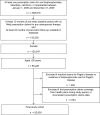Discontinuation and reinitiation patterns of osteoporosis treatment among commercially insured postmenopausal women
- PMID: 24235846
- PMCID: PMC3825671
- DOI: 10.2147/IJGM.S36944
Discontinuation and reinitiation patterns of osteoporosis treatment among commercially insured postmenopausal women
Abstract
Objective: Poor adherence to chronic medications is common and compromises medication effectiveness. We sought to describe longitudinal patterns of osteoporosis medication use.
Study design: This was a retrospective observational cohort study using 2005-2009 data from a large, commercially insured population.
Methods: Patients were women aged ≥55 years initiating osteoporosis therapy who had a ≥12-month (baseline) period with no osteoporosis therapy claims preceding initiation, and ≥24 months follow-up after therapy initiation. Discontinuation was defined as a gap >60 days (varied in sensitivity analyses) in prescription claims. Reinitiation was defined as a prescription claim for the same or different osteoporosis therapy following the therapy gap. Discontinuation and reinitiation patterns were described using Kaplan-Meier analysis. Multivariable Cox regression assessed the impact of baseline factors on reinitiation.
Results: Of the 92,839 patients, 45%, 58%, and 70% discontinued therapy at 6, 12, and 24 months, respectively, following initiation. Of the discontinuers, 46% reinitiated therapy, with the majority doing so within 6 months of discontinuation. Women were less likely to reinitiate therapy if they were older (P < 0.0001) or were hospitalized during baseline (P = 0.0007). Women who discontinued treatment early (<6 months) following initiation were less likely to reinitiate (P < 0.0001) and remained on therapy for shorter periods following reinitiation. Depending on the available observation time, the median time on therapy following reinitiation was 58-193 days. Study findings did not change appreciably in sensitivity analyses.
Conclusion: Many patients stop and restart treatment for osteoporosis. A better understanding of determinants of treatment stopping and restarting could inform adherence improvement efforts.
Keywords: adherence; bisphosphonates; osteoporosis; persistence; therapy utilization.
Figures
Comment in
-
Do women really take their osteoporosis therapy?Climacteric. 2014 Apr;17(2):204-5. doi: 10.3109/13697137.2014.884273. Climacteric. 2014. PMID: 24628005 No abstract available.
References
-
- Boonen S, Autier P, Barette M, Vanderschueren D, Lips P, Haentjens P. Functional outcome and quality of life following hip fracture in elderly women: a prospective controlled study. Osteoporos Int. 2004;15(2):87–94. - PubMed
-
- Fast facts on osteoporosis [webpage on the Internet] Washington, DC: National Osteoporosis Foundation; Available from: http://www.nof.org/articles/7Accessed August 20, 2013
-
- Siris ES, Selby PL, Saag KG, Borgstrom F, Herings RM, Silverman SL. Impact of osteoporosis treatment adherence on fracture rates in North America and Europe. Am J Med. 2009;122(Suppl 2):S3–S13. - PubMed
-
- Clinician’s Guide to Prevention and Treatment of Osteoporosis Washington, DC: National Osteoporosis Foundation; 2013Available from: http://nof.org/hcp/resources/913Accessed August 20, 2013
LinkOut - more resources
Full Text Sources
Other Literature Sources
Miscellaneous



